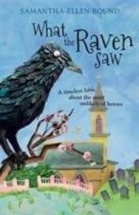What the Raven Saw by Samantha-Ellen Bound

Woolshed Press (Random House Australia), 2013. ISBN 9781742757353.
pbk., RRP $A16.95. Ebook: 9781742757360288.
Vain, arrogant and grumpy, Raven lives in the belltower of an old
country church surveying all that goes on below with a very
judgemental eye. He is convinced that the weatherhen who
swings with the wind with a range of rusty tunes is in love with
him, and he is contemptuous of all his other feathered relations,
particularly the pigeons. What Raven does like is the music
which soars from the church during Sunday Mass, so much so that he
has revealed his deepest secret to Father Cadman - ravens can talk
to humans, and so after the congregation has left, he joins Father
Cadman at the ancient organ so he can learn to sing the hymns.
The story opens with Raven watching the funeral of Todd Trebuchet, a
young boy killed by a car after a row with his sister and it is his
conversations with Todd's ghost and the distress of McKenzie, his
sister, that begins Raven's journey of seeing more than that which
physically surrounds him. Making a T of the bottletops (specially
shined with eucalyptus) that are part of his precious, closely
guarded treasure to mark Todd's as yet unmarked grave, is the start.
But it is when, from his perch in the rafters above the Sunday
congregation, he sees Barnabas Brittle pocketing part of the
collection and other treasures, that the journey really
begins. Knowing how he feels about his own treasure, he tells
Father Cadman of the theft, but, to his astonishment, Father Cadman
does not believe him and bans him from the church and his beloved
music.
While the along-the-lines story tells of how Raven enlists the help
of Todd, McKenzie, the other ghosts and even the pigeon to show
Father Cadman that Brittle is, indeed, a thief so that he can again
enjoy the hymns, it is the between-the-lines story of what Raven
learns from those he considers to be his inferiors, that give this
story its richness.From a suicidal public servant to a
dilapidated, out-dated scarecrow, he learns a little about
compassion and humility, companionship and modesty - Raven at the
end of the story is quite different from Raven at the
beginning. He even views Weatherhen and Pigeon differently.
While younger, independent readers could read and enjoy this story,
as much for its different approach as anything else, I believe
someone with the maturity to be able to view it a little more
objectively to delve into its underlying message will enjoy its
depth. It would be very well suited to a guided reading text
for upper primary students with a teacher leading the way to show
students how there is often much, if not more, to a story if they
take the time to ask the critical questions to prise out the
between-and-beyond the lines story. It would be a great starting
point to help them develop those skills required to interrogate a
story which they will be expected to have when they go to high
school and are confronted by some of the classics that are so much
more than a few hours of entertainment.
This is the author's first published novel but, if this is the
calibre of her storytelling, she is certainly a new Australian
author to look for in the future.
Barbara Braxton